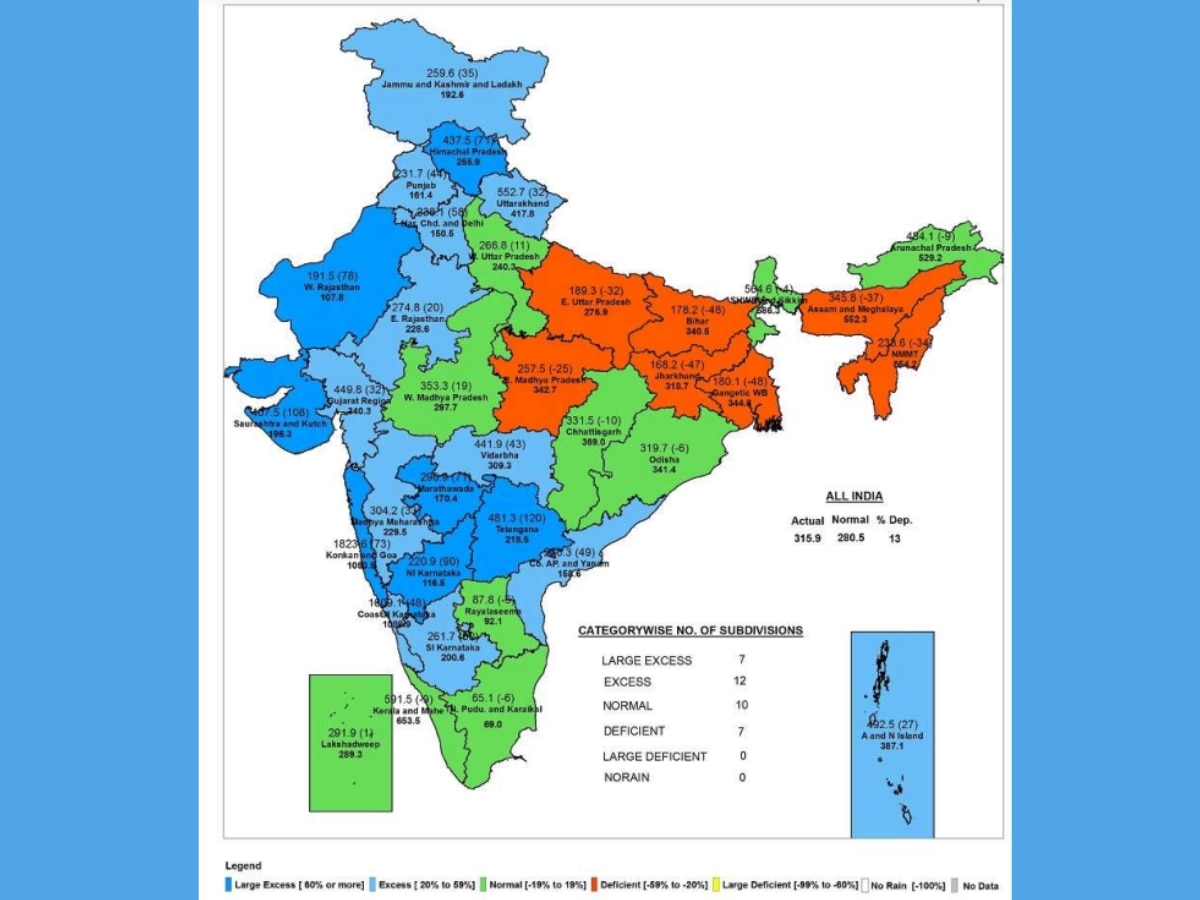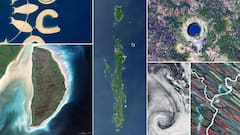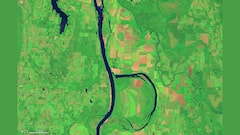Why Did Eastern Parts Of India Receive Less Rainfall Than Other Regions This Year? Experts Give Reasons
East and northeast India received 286.8 mm rainfall in July, which is 32 per cent less than the normal rainfall level of 424.1 mm. The changing routes of weather systems caused the rain deficit.

Rainfall deficit in eastern parts of India: This monsoon, less than normal rainfall occurred over the eastern parts of India, which include eastern Uttar Pradesh, eastern Madhya Pradesh, Bihar, Jharkhand, Gangetic West Bengal, Assam, Meghalaya, Nagaland, Manipur, Mizoram and Tripura. Regions such as Vidarbha, central Maharashtra, east Gujarat, east Rajasthan, Delhi, Punjab, and Uttarakhand received excess rainfall in July, according to the India Meteorological Organization (IMD). Areas like Telangana, north Karnataka, Vidarbha, west Gujarat and west Rajasthan received large excess rainfall this monsoon. Surprisingly, Tamil Nadu, which is a rain deficit region, obtained some good spells of rain this year.
As a whole, India, in July 2023, received 13 per cent higher rainfall than the long-period average of 280.5 millimetres (mm). According to the IMD, Northwest India, in July, received 261.4 mm rainfall, which is 25 per cent higher than the long-period average of 209.7 mm. Central India received 391.4 mm rainfall in July, which is 22 per cent higher than the long-period average of 321.3 mm, and the southern peninsula received 295.5 mm rainfall in July, which is 45 per cent higher than the long-period average of 204.5 mm.
| Regions | Actual Rainfall (mm) | Normal Rainfall (mm) | % Departure From LPA |
| India as a whole | 315.9 | 280.5 | 13 |
| Northwest India | 261.4 | 209.7 | 25 |
| Central India | 391.4 | 321.3 | 22 |
| Southern Peninsula | 295.5 | 204.5 | 45 |
| East and northeast India | 286.8 | 424.1 | -32 |
Source of the information mentioned in the table: IMD
Why east and northeast India received less than normal rainfall this monsoon
East and northeast India received 286.8 mm rainfall in July, which is 32 per cent less than the normal rainfall level of 424.1 mm.
Reduced rainfall impacts agriculture. Not only does this result in economic difficulties for farmers, but also causes water scarcity for animals.

ABP Live spoke to Mahesh Palawat, Vice President, Meteorology and Climate Change, Skymet Weather, and Dr Anjal Prakash, Clinical Associate Professor (Research) and Research Director, Bharti Institute of Public Policy, Indian School of Business, and asked them about the scientific reason behind eastern and northeastern states receiving less rainfall.
According to Palawat, this year, less than normal rainfall occurred over the eastern parts of the country, which include east Uttar Pradesh, Bihar, Jharkhand, and Odisha. He added that parts of Karnataka and Kerala also received less than normal rainfall this year.
Palawat attributed the weather system that develops over the Bay of Bengal as being responsible for less than normal rainfall over eastern parts of India. "The reason why the eastern parts of India are receiving less than normal rainfall is the weather system that develops over the Bay of Bengal. Earlier, they used to travel in the northwest direction across north Odisha, Jharkhand, Bihar, Uttar Pradesh, and reached Punjab across Delhi and Haryana. Therefore, northwest India usually receives more rainfall than other parts of the country. However, for the last few years, the weather system developing over Bay of Bengal has been taking the westerly route. The weather system has taken the route across south Odisha, north coastal Andhra Pradesh, north Telangana, Vidarbha, south Madhya Pradesh, Gujarat and south Rajasthan. As a result, these areas have been receiving heavy downpours. Due to these reasons, for the last few years, the central parts of India have been receiving more than normal. The same pattern is emerging this year as well. Since the weather system is travelling towards the west, the eastern parts of the country are almost deficient. One can say that there is a dearth of rainfall in these areas."
Palawat also said that Tamil Nadu usually does not receive enough rain during monsoon, but this year, due to the formation of a weather system over southwest Bay of Bengal, Tamil Nadu has recorded a few good spells of rain.
He explained that rainfall over regions of northwest India, which include Punjab, Delhi and Haryana, can be attributed to the formation of a cyclonic circulation over Punjab and adjoining parts of Pakistan. "A western disturbance over north Pakistan had formed. Due to this, Delhi, the National Capital Regions (NCR), and parts of Punjab and Haryana received very heavy rainfall on July 8 and 9. So, this may be the reason why these areas received sufficient rainfall."
He said that the main reason is climate change, because of which the monsoon pattern is changing.
Dr Prakash explained that regional climate patterns and climate change impacts are responsible for the variation in rainfall in different parts of the country. He also said that climate change alters atmospheric circulation and ocean currents, and results in shifts in rainfall distribution.
Explaining why northwestern parts of India received more rainfall than eastern regions, Dr Prakash said: “Certain regions may face more intense droughts, while others receive increased rainfall, leading to disparities between neighbouring states. The differing rainfall between Tamil Nadu, Delhi, Bihar, and Jharkhand can be attributed to complex interactions of climate systems, including monsoon winds, ocean temperatures, and geographical factors. Different climate drivers favour or inhibit rainfall in specific areas, emphasising the intricacies of climate and weather patterns influenced by human-induced climate change.”
How agriculture is impacted in rain-deficit states
As discussed, the eastern and northeastern regions of the country, along with some southern states, received less than normal rainfall this year. This leads to reduced crop yields as well as economic problems for farmers.
Dr Prakash said that insufficient rainfall impacts both rain-fed agriculture and irrigation-dependent crops. “Crops like rice, maize, millets, pulses, and oilseeds are severely affected. Farmers may face water shortages, increased irrigation costs, and crop failures, leading to decreased agricultural productivity and income. Additionally, prolonged droughts can lead to livestock feed scarcity and water scarcity for animals, further impacting the overall agricultural sector.”
He explained that in order to help farmers cope with the challenges posed by inadequate rainfall, government interventions such as water management strategies, crop diversification, and financial support are important.
Rainfall conditions predicted for the rest of monsoon
The IMD has said that rain activities are likely to intensify over the eastern parts of the country from August 8 to 10. These regions include West Bengal, Bihar, Jharkhand, and Sikkim. Over the next five days, Arunachal Pradesh, Assam, Meghalaya, Nagaland, Manipur, Mizoram, and Tripura are likely to receive heavy to very rainfall, an IMD statement dated August 8, 2023, said.
According to Palawat, the low-pressure areas over the Indo-Gangetic Plain, which lie above Uttar Pradesh, will bring rain over Uttar Pradesh, Bihar, Jharkhand, West Bengal, Punjab, Haryana and Delhi over the next few days.
"After August 8, the monsoon rains will start decreasing, or will become weaker than normal because of the El Niño impact. Overall, monsoon rains will start decreasing in the remainder of August and September. During the remaining part of August, and the entire month of September, monsoon will be subdued. As of now, there is surplus rain over the entire country. But this will reduce, and the monsoon may end with a slightly lower than normal rainfall," Palawat said.
He explained that the monsoon season this year may end with rainfall which is 96 to 104 per cent of normal. "Skymet has predicted that the monsoon season may end with 94 to 96 per cent of normal rainfall."
Trending News
Top Headlines









































